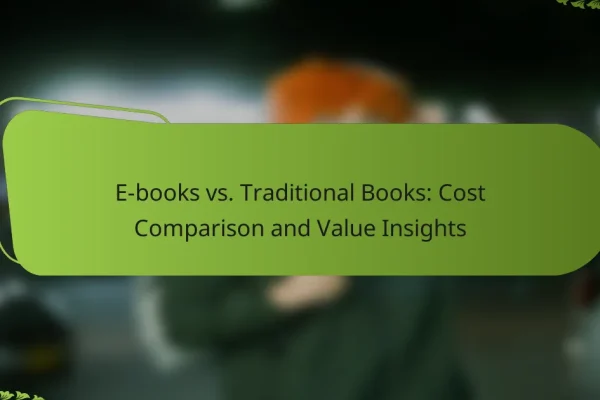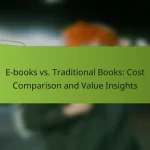How can e-books enhance learning in the United States?
E-books can significantly enhance learning in the United States by providing interactive and engaging content that caters to various learning styles. They offer features that traditional textbooks cannot, making education more accessible and affordable for students across the country.
Interactive features
E-books often include interactive elements such as quizzes, videos, and hyperlinks that can make learning more engaging. These features allow students to test their knowledge immediately and explore related topics in depth, enhancing comprehension and retention. For instance, a student reading about a historical event can click on links to primary sources or related multimedia content.
Additionally, many e-books offer customizable reading experiences, such as adjustable text sizes and background colors, which can help maintain focus and improve understanding. These interactive features can transform passive reading into an active learning experience.
Accessibility for diverse learners
E-books improve accessibility for diverse learners by providing options that cater to various needs. Features like text-to-speech, adjustable font sizes, and the ability to highlight or annotate text make it easier for students with disabilities to engage with the material. This adaptability ensures that all learners, including those with visual impairments or learning disabilities, can access educational content effectively.
Moreover, e-books can be accessed on multiple devices, allowing students to learn anytime and anywhere. This flexibility is particularly beneficial for those who may not have access to physical textbooks or who prefer to study on the go.
Cost-effectiveness compared to traditional textbooks
E-books are generally more cost-effective than traditional textbooks, often costing significantly less. Students can save money on course materials, with many e-books available for purchase or rental at a fraction of the price of printed versions. This affordability can alleviate financial burdens, especially for college students facing high tuition costs.
Furthermore, e-books eliminate the need for physical storage and can be updated more easily than traditional textbooks, ensuring that students have access to the latest information without additional costs. Schools and institutions can also benefit from bulk purchasing options that further reduce expenses.
What are the best e-book platforms for educational content?
The best e-book platforms for educational content include Amazon Kindle, Apple Books, and Google Play Books. Each platform offers unique features and resources that cater to different learning needs and preferences.
Amazon Kindle for Education
Amazon Kindle is a popular choice for educational e-books, offering a vast library of titles across various subjects. Users can access textbooks, study guides, and literature, often at lower prices than traditional print editions.
Kindle’s features, such as adjustable font sizes, built-in dictionaries, and note-taking capabilities, enhance the learning experience. Additionally, the Kindle app is available on multiple devices, making it easy to study on the go.
Apple Books for Learning
Apple Books provides a user-friendly interface and a curated selection of educational materials. It allows users to purchase and download e-books directly to their Apple devices, ensuring seamless access.
With features like highlighting, bookmarks, and the ability to listen to audiobooks, Apple Books caters to diverse learning styles. The platform also offers a range of free educational resources, making it an attractive option for students.
Google Play Books for Students
Google Play Books is another excellent platform for students, featuring a wide array of educational e-books and study materials. Users can purchase or rent books, which can be a cost-effective option for those on a budget.
The platform supports various formats and allows users to upload their own PDFs and EPUBs, providing flexibility in accessing learning materials. Google Play Books also integrates with Google Drive, making it easy to store and share notes and highlights.
How do e-books compare to traditional textbooks?
E-books offer several advantages over traditional textbooks, including enhanced accessibility and interactive features. While traditional textbooks provide a tactile experience, e-books are often more cost-effective and can be easily updated to reflect the latest information.
Portability and convenience
E-books are highly portable, allowing users to carry an entire library on a single device. This convenience is particularly beneficial for students and professionals who travel frequently or have limited storage space.
Many e-readers and tablets are lightweight and can fit into a backpack or handbag, making it easy to access materials anywhere. Additionally, e-books can be read on various devices, including smartphones and laptops, providing flexibility in how and where you study.
Searchable content and quick navigation
One of the key benefits of e-books is their searchable content, which allows users to find specific information quickly. Instead of flipping through pages, readers can use keywords to locate topics or terms in seconds.
Many e-books also feature hyperlinks and interactive elements, enabling users to navigate between sections or access additional resources seamlessly. This functionality can enhance the learning experience by making information retrieval more efficient.
Environmental impact considerations
E-books generally have a lower environmental impact compared to traditional textbooks, as they do not require paper, ink, or physical transportation. This can contribute to a reduction in deforestation and carbon emissions associated with book production and distribution.
However, it is important to consider the environmental cost of electronic devices, including energy consumption and e-waste. Choosing energy-efficient devices and recycling old electronics can help mitigate these impacts while enjoying the benefits of digital learning tools.
What criteria should educators use to select e-books?
Educators should prioritize criteria such as content quality, user engagement features, and compatibility with learning management systems when selecting e-books. These factors significantly influence the effectiveness of e-books as learning tools.
Content quality and relevance
Content quality is paramount in e-books, as it directly impacts student learning. Educators should look for e-books that are well-researched, up-to-date, and aligned with curriculum standards. Additionally, the relevance of the material to the subject matter and the educational goals is crucial.
Consider checking reviews or ratings from other educators and institutions to gauge the effectiveness of the e-book. A good practice is to preview the e-book’s table of contents and sample chapters to ensure it meets the educational needs.
User engagement features
User engagement features enhance the learning experience by making it interactive and enjoyable. Look for e-books that include multimedia elements, such as videos, quizzes, and interactive exercises, which can help maintain student interest and facilitate deeper understanding.
Features like highlighting, note-taking, and bookmarking can also improve usability. Ensure that the e-book allows for easy navigation and provides feedback mechanisms to track student progress.
Compatibility with learning management systems
Compatibility with learning management systems (LMS) is essential for seamless integration into existing educational frameworks. Educators should verify that the e-book can be easily uploaded and accessed through popular LMS platforms like Moodle, Canvas, or Blackboard.
Check if the e-book supports common file formats such as EPUB or PDF, which are typically compatible with various LMS. Additionally, ensure that it allows for tracking of student engagement and performance metrics to facilitate assessment and reporting.
What are the emerging trends in e-books for education?
Emerging trends in e-books for education focus on enhancing interactivity and personalization to improve learning outcomes. These trends include the integration of augmented reality, personalized learning experiences, and collaborative features that facilitate group learning.
Integration of augmented reality
Augmented reality (AR) in e-books allows students to engage with content in a more immersive way. For instance, students can scan images within an e-book to view 3D models or animations that illustrate complex concepts, making learning more engaging and effective.
When implementing AR, consider the technical requirements such as compatible devices and software. Ensure that the AR features align with educational goals and do not distract from the core content.
Personalized learning experiences
Personalized learning experiences in e-books adapt content to meet individual student needs, preferences, and learning paces. This can include adjustable reading levels, tailored quizzes, and recommendations for further reading based on performance.
To create effective personalized experiences, utilize data analytics to track student progress and preferences. This approach can help educators identify areas where students may need additional support or enrichment.
Collaborative features for group learning
Collaborative features in e-books enable students to work together on projects or assignments, fostering teamwork and communication skills. Features may include shared notes, discussion boards, or group quizzes that encourage interaction among peers.
When selecting e-books with collaborative tools, look for platforms that support real-time collaboration and easy sharing of resources. This can enhance the learning experience and build a sense of community among students.




